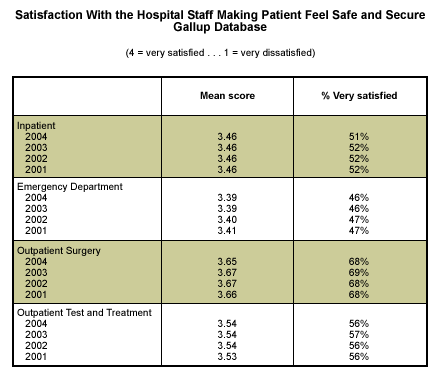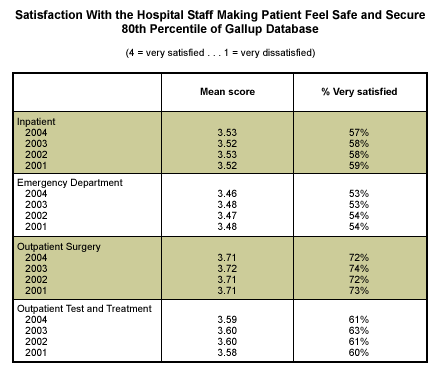There's an old joke that if you stay in a hospital long enough, you'll get sick. But that joke became no laughing matter in November 1999, when an Institute of Medicine study revealed that between 44,000 and 98,000 Americans die every year because of medical errors. Since the report's release, hospitals have spent countless dollars and hours on creating new clinical information systems and uniform electronic medical records, updating protocols, policies and procedures, and training staff. The government has launched major initiatives. Reporting requirements for adverse incidents have tightened.
One important question remains: Do patients feel safer in the hospital today than they did a few years ago? The short answer is no, according to results from Gallup's recently released 2004 healthcare database.
How Safe Do Patients Feel in the Hospital?
Gallup routinely asks patients to rate their satisfaction with how "safe and secure" the hospital staff made them feel on a scale of 1 to 4. The 2004 database shows the percentage of "very satisfied" patients (those giving a score of 4) ranges from 68% of outpatient surgery patients to only 46% of emergency department patients. Among best-practice hospitals -- those scoring in the 80th percentile of Gallup's database with regard to patient ratings on all aspects of hospital stays -- 72% of outpatient surgery patients say they are very satisfied with their safety and security, as are 53% of emergency department patients. Inpatient and outpatient test and treatment departments fall somewhere in between.

Despite all the recent efforts to reduce medical errors, these numbers haven't improved since 2001. In outpatient surgery, the best performing of the four areas that Gallup measures, patient satisfaction with safety and security has actually eroded to its lowest level since 2001. In the emergency department, the area with the most room for improvement, satisfaction with safety and security has not changed at all in the last year -- it has also declined slightly since 2001.
Safety and Security in Best-Practice Facilities
Sometimes improvement on specific satisfaction items will show up first in best-practice healthcare facilities, those that are already outperforming average facilities. But the 80th-percentile facilities in Gallup's database have shown just as little change in patient satisfaction with safety and security as those with lower overall ratings.

If ratings of best-practice facilities serve as a leading indicator of improvement, the numbers aren't encouraging. Change has occurred at the 80th percentile level, but it has been in the wrong direction. Scores at the best-practice level have declined slightly. The percentage of patients very satisfied with safety and security is at its lowest level since 2001 in every area except outpatient test and treatment.
Bottom Line
Patients do not feel safer in hospitals today than they did four years ago. Several possible explanations exist for the lack of improvement. First and foremost, investments in information systems and changes in policies and procedures are often invisible to patients. Hospitals may actually be preventing errors, but patients don't notice a lack of errors; they only notice when errors occur.
What patients do notice is whether healthcare employees listen to what they have to say and take their opinions to heart. If a patient feels that a nurse doesn't care or doesn't have time to help, the patient might not tell the nurse how he or she is feeling, and this lack of communication can lead to errors.
System changes are only as effective as the people who implement them. Many errors are made not because of faulty systems or procedures themselves, but because of a failure to comply with procedures or a simple failure to care enough. To see real improvement, hospitals need to shift their focus from technology and process to people. Improving patient-employee relations will not only prevent errors from occurring, but will also give patients a more general sense of safety and security, which will show through in their satisfaction scores.